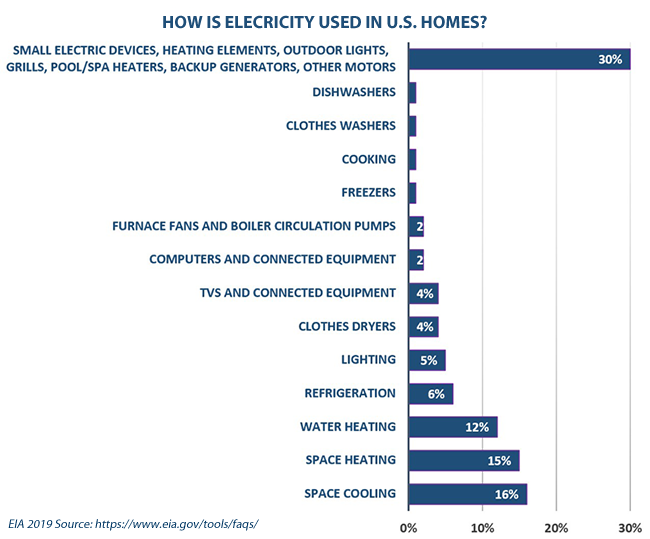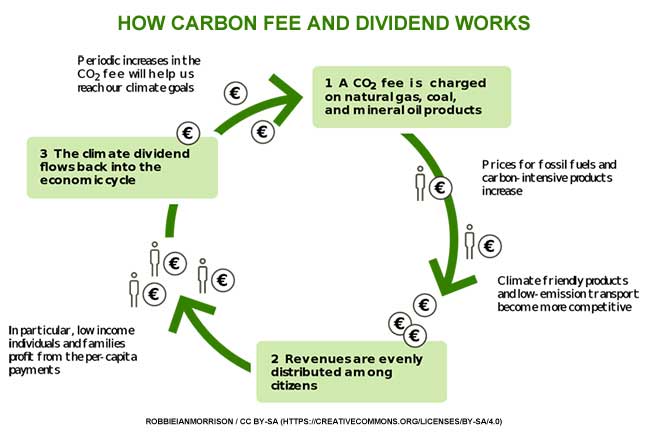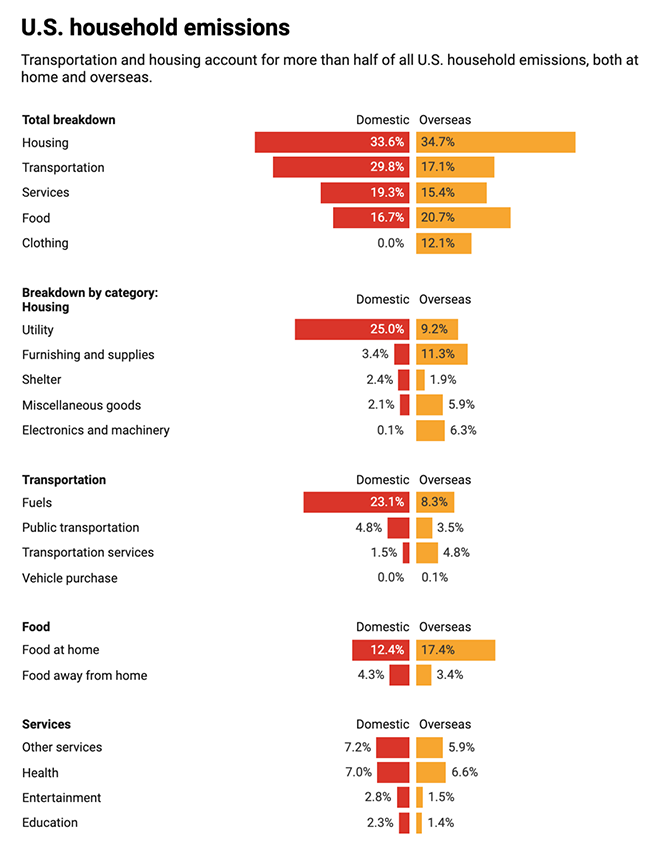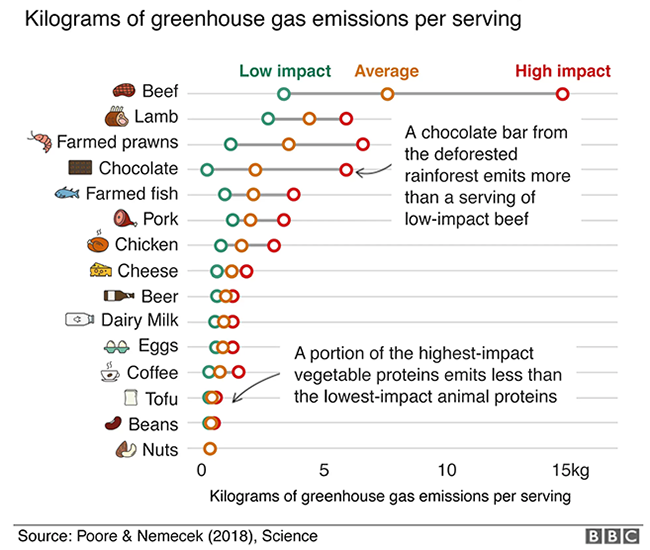 Home > All Green Living > Top 20 Ways to Reduce Your Carbon Footprint
Home > All Green Living > Top 20 Ways to Reduce Your Carbon Footprint
Top 20 Ways to Reduce Your Carbon Footprint
Updated: August 15, 2024

Below are top twenty ways we can reduce our carbon footprint based on the sources of average household carbon emissions and BBC's research on most effective actions.
SECTIONS: housing, transportation, food, products and services, educate and advocate

Housing
- Switch to renewables: Switch to powering your home with renewables through:
- Reduce energy use: Quick steps:
- Focus mainly on buying efficient space heating/cooling, water heating, cooking, and refrigeration. For greatest carbon reductions, switch your air heating and cooling equipment to a heat pump (guides by the DOE and EPA), water heater to a heat pump (or cut heating costs with solar) and stovetop or range to an induction option.
- Make energy efficient home improvements based on an energy audit (EPA online tools).
- If you're moving, check out the new area's walk score to find neighborhoods that require less (or no) driving
- Install a programmable (smart) thermostat
- Seal your heating and cooling ducts
- Add insulation and weather-stripping - especially for doors, windows, attic and attic door
- Switch to LED lightbulbs
- Buy energy efficient appliances in general
- Turn off lights and electronics when not in use
- Unplug devices to prevent "phantom" or standby energy consumption
- Adjust your thermostat a few degrees lower in winter and higher in summer to save a significant amount of energy
- Keep up on regular equipment maintenance
- Buy energy efficient office equipment
- Buy human-powered vs. gas- or electric-powered equipment and appliances
- Minimize use of fireplaces or wood stoves
- Wash full loads of clothes in cold water and hang them to dry
- Check lights, appliances, and curtains every morning and night and anytime you leave home

- Embrace minimalist or slow decorating:
Slow decorating is an eco-conscious approach to interior design, focusing on gradually curating spaces with thoughtfully chosen, sustainable (ideally used), and often locally sourced pieces. It emphasizes quality and longevity over speed.
- Conserve water: Using less water reduces the energy required to process and deliver it, thereby reducing carbon pollution. Buy low flow shower and faucet heads, water (and energy) efficient toilets/clothes washers/dishwashers, check for leaks often, and create a native, xeriscape garden.
- Plant trees: Trees not only absorb CO2, but planting trees and bushes strategically near your home helps to reduce both your cooling and heating bills.
- Offset your carbon footprint: While not a substitute for reducing emissions, investing in carbon offset projects can help compensate for your unavoidable emissions. Calculate your carbon footprint and buy carbon offsets from a certified provider (U.S. and Canada).
Transportation
- Drive less or go car free: Minimize driving by walking, biking, carpooling, telecommuting, and using public transit as much as possible. Set a goal of walking or biking anywhere within 2 miles of your home. Consider buying an e-bike if it will make it easier to skip the car and expand your biking range. If you live in a city, consider using car sharing (scroll to member logos) services instead of owning a car. Per BBC's research, switching to a car-free lifestyle is the most effective action you can take to reduce your footprint.
- Drive a fuel-efficient (ideally all-electric) vehicle: If needed, choose a fuel-efficient used car (research models via Alternative Fuel and Advanced Vehicle or Smartways search tools). Per BBC's research, switching to an electric vehicle is the 2nd most effective action you can take to reduce your footprint.
- Embrace slow travel: Limiting air travel or choosing lower-carbon transportation options can significantly reduce your carbon footprint. If you do fly, purchase carbon offsets (select "Individual" then click on the airplane icon to view the airplane carbon calculator). Support green hotel practices.
Products and Services
- Choose sustainable clothing (aka slow fashion): Buy clothing that supports both the environment and garment workers. Buy used whenever possible and build a second hand capsule wardrobe to help speed the shift away from trendy clothing.
- Buy used: Manufacturing products requires energy and resources, contributing to carbon emissions, habitat destruction and pollution. Minimize purchases of new products, especially resource-intensive, heavy or heavily-packaged ones.
- Embrace a minimalist lifestyle: Declutter your home and donate or sell items to give them another life. Online bartering or swapping groups can turn this effort into a fun way to meet people in the community.
- Reduce, reuse, recycle: Minimizing waste by reusing items, recycling, and buying products with minimal packaging (especially for repeat purchases) helps cut carbon emissions from waste management. Research ways to recycle hard-to-recycle items in your local community. Choose zero-waste solutions wherever possible.
- Replace single-use items: Finding long-lasting alternatives to single-use items made of plastic and other materials is a great way to reduce emissions, pollution and waste. Next time you're putting together your shopping list, note any single-use products and research sustainable (ideally used) alternatives for each.
- Support sustainable brands: Purchase from companies that are committed to reducing their carbon footprint and prioritize sustainability.
- Choose lower carbon products, services and activities/hobbies: When considering purchases, look for the lowest carbon option (i.e., tap water vs. bottled, shampoo bar vs. bottle, massage vs. spa, kayaking vs. jet skiing, bicycling vs. motor biking). Be conscious of how your income and reference group (the people we compare ourselves to and identify with) may be impacting your GHG emissions:

Educate and Advocate
- Encourage and support greenhouse-reducing practices in your community:



MORE








